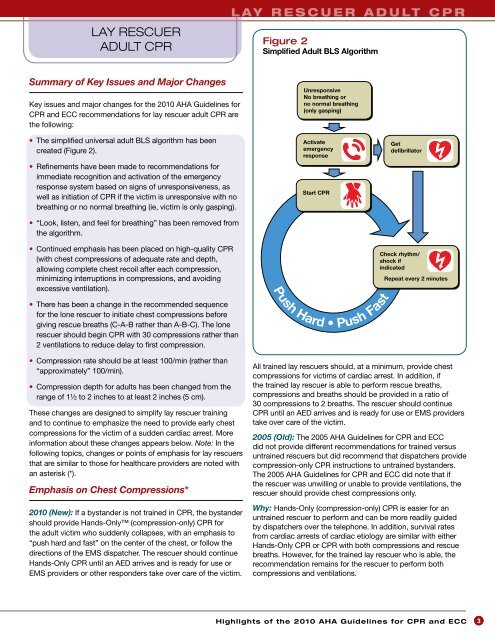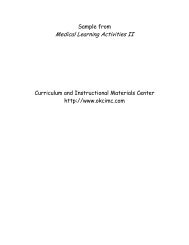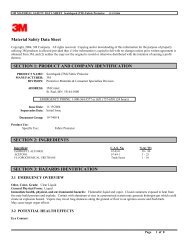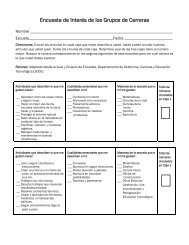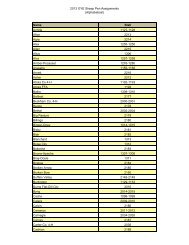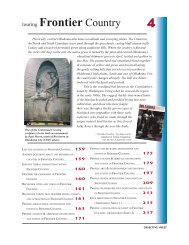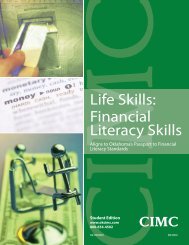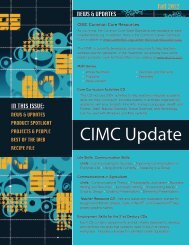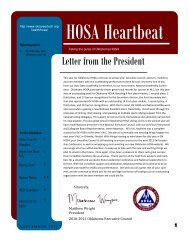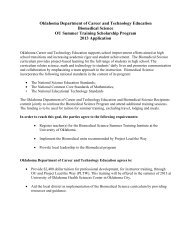Highlights of the 2010 Guidelines for CPR and ECC - ECC Guidelines
Highlights of the 2010 Guidelines for CPR and ECC - ECC Guidelines
Highlights of the 2010 Guidelines for CPR and ECC - ECC Guidelines
You also want an ePaper? Increase the reach of your titles
YUMPU automatically turns print PDFs into web optimized ePapers that Google loves.
LAY RESCUER<br />
ADULT <strong>CPR</strong><br />
H e allt a y h rC ea sr ce uPe r oa vd i du elt r cb pl rs<br />
Figure 2<br />
Simplified Adult BLS Algorithm<br />
Summary <strong>of</strong> Key Issues <strong>and</strong> Major Changes<br />
Key issues <strong>and</strong> major changes <strong>for</strong> <strong>the</strong> <strong>2010</strong> AHA <strong>Guidelines</strong> <strong>for</strong><br />
<strong>CPR</strong> <strong>and</strong> <strong>ECC</strong> recommendations <strong>for</strong> lay rescuer adult <strong>CPR</strong> are<br />
<strong>the</strong> following:<br />
• The simplified universal adult BLS algorithm has been<br />
created (Figure 2).<br />
• Refinements have been made to recommendations <strong>for</strong><br />
immediate recognition <strong>and</strong> activation <strong>of</strong> <strong>the</strong> emergency<br />
response system based on signs <strong>of</strong> unresponsiveness, as<br />
well as initiation <strong>of</strong> <strong>CPR</strong> if <strong>the</strong> victim is unresponsive with no<br />
breathing or no normal breathing (ie, victim is only gasping).<br />
• “Look, listen, <strong>and</strong> feel <strong>for</strong> breathing” has been removed from<br />
<strong>the</strong> algorithm.<br />
Simplified Adult BLS<br />
Unresponsive<br />
No breathing or<br />
no normal breathing<br />
(only gasping)<br />
Activate<br />
emergency<br />
response<br />
Start <strong>CPR</strong><br />
Get<br />
defibrillator<br />
• Continued emphasis has been placed on high-quality <strong>CPR</strong><br />
(with chest compressions <strong>of</strong> adequate rate <strong>and</strong> depth,<br />
allowing complete chest recoil after each compression,<br />
minimizing interruptions in compressions, <strong>and</strong> avoiding<br />
excessive ventilation).<br />
• There has been a change in <strong>the</strong> recommended sequence<br />
<strong>for</strong> <strong>the</strong> lone rescuer to initiate chest compressions be<strong>for</strong>e<br />
giving rescue breaths (C-A-B ra<strong>the</strong>r than A-B-C). The lone<br />
rescuer should begin <strong>CPR</strong> with 30 compressions ra<strong>the</strong>r than<br />
2 ventilations to reduce delay to first compression.<br />
• Compression rate should be at least 100/min (ra<strong>the</strong>r than<br />
“approximately” 100/min).<br />
• Compression depth <strong>for</strong> adults has been changed from <strong>the</strong><br />
range <strong>of</strong> 1½ to 2 inches to at least 2 inches (5 cm).<br />
These changes are designed to simplify lay rescuer training<br />
<strong>and</strong> to continue to emphasize <strong>the</strong> need to provide early chest<br />
compressions <strong>for</strong> <strong>the</strong> victim <strong>of</strong> a sudden cardiac arrest. More<br />
in<strong>for</strong>mation about <strong>the</strong>se changes appears below. Note: In <strong>the</strong><br />
following topics, changes or points <strong>of</strong> emphasis <strong>for</strong> lay rescuers<br />
that are similar to those <strong>for</strong> healthcare providers are noted with<br />
an asterisk (*).<br />
Emphasis on Chest Compressions*<br />
<strong>2010</strong> (New): If a byst<strong>and</strong>er is not trained in <strong>CPR</strong>, <strong>the</strong> byst<strong>and</strong>er<br />
should provide H<strong>and</strong>s-Only (compression-only) <strong>CPR</strong> <strong>for</strong><br />
<strong>the</strong> adult victim who suddenly collapses, with an emphasis to<br />
“push hard <strong>and</strong> fast” on <strong>the</strong> center <strong>of</strong> <strong>the</strong> chest, or follow <strong>the</strong><br />
directions <strong>of</strong> <strong>the</strong> EMS dispatcher. The rescuer should continue<br />
H<strong>and</strong>s-Only <strong>CPR</strong> until an AED arrives <strong>and</strong> is ready <strong>for</strong> use or<br />
EMS providers or o<strong>the</strong>r responders take over care <strong>of</strong> <strong>the</strong> victim.<br />
Push Hard • Push Fast<br />
Check rhythm/<br />
shock if<br />
indicated<br />
Repeat every 2 minutes<br />
© <strong>2010</strong> American Heart Association<br />
All trained lay rescuers should, at a minimum, provide chest<br />
compressions <strong>for</strong> victims <strong>of</strong> cardiac arrest. In addition, if<br />
<strong>the</strong> trained lay rescuer is able to per<strong>for</strong>m rescue breaths,<br />
compressions <strong>and</strong> breaths should be provided in a ratio <strong>of</strong><br />
30 compressions to 2 breaths. The rescuer should continue<br />
<strong>CPR</strong> until an AED arrives <strong>and</strong> is ready <strong>for</strong> use or EMS providers<br />
take over care <strong>of</strong> <strong>the</strong> victim.<br />
2005 (Old): The 2005 AHA <strong>Guidelines</strong> <strong>for</strong> <strong>CPR</strong> <strong>and</strong> <strong>ECC</strong><br />
did not provide different recommendations <strong>for</strong> trained versus<br />
untrained rescuers but did recommend that dispatchers provide<br />
compression-only <strong>CPR</strong> instructions to untrained byst<strong>and</strong>ers.<br />
The 2005 AHA <strong>Guidelines</strong> <strong>for</strong> <strong>CPR</strong> <strong>and</strong> <strong>ECC</strong> did note that if<br />
<strong>the</strong> rescuer was unwilling or unable to provide ventilations, <strong>the</strong><br />
rescuer should provide chest compressions only.<br />
Why: H<strong>and</strong>s-Only (compression-only) <strong>CPR</strong> is easier <strong>for</strong> an<br />
untrained rescuer to per<strong>for</strong>m <strong>and</strong> can be more readily guided<br />
by dispatchers over <strong>the</strong> telephone. In addition, survival rates<br />
from cardiac arrests <strong>of</strong> cardiac etiology are similar with ei<strong>the</strong>r<br />
H<strong>and</strong>s-Only <strong>CPR</strong> or <strong>CPR</strong> with both compressions <strong>and</strong> rescue<br />
breaths. However, <strong>for</strong> <strong>the</strong> trained lay rescuer who is able, <strong>the</strong><br />
recommendation remains <strong>for</strong> <strong>the</strong> rescuer to per<strong>for</strong>m both<br />
compressions <strong>and</strong> ventilations.<br />
<strong>Highlights</strong> <strong>of</strong> <strong>the</strong> <strong>2010</strong> AHA <strong>Guidelines</strong> <strong>for</strong> <strong>CPR</strong> <strong>and</strong> <strong>ECC</strong><br />
43


